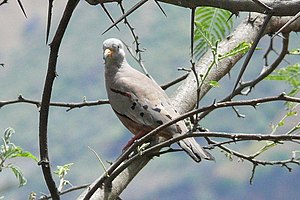Peruvian pigeon
| Peruvian pigeon | ||||||||||
|---|---|---|---|---|---|---|---|---|---|---|

Peruvian pigeon ( Columbina cruziana ) |
||||||||||
| Systematics | ||||||||||
|
||||||||||
| Scientific name | ||||||||||
| Columbina cruziana | ||||||||||
| ( Prévost , 1842) |
The croaking ground dove ( Columbina cruziana ), also Goldschnabeltäubchen called, is a type of pigeon birds, to the subfamily of American small pigeons are expected. The species occurs exclusively in South America and is not considered endangered. In German usage, the perute dove has a very similar name. However, this species belongs to the genus of weeping pigeons .
Appearance
The Peruvian pigeon reaches a body length of 15 centimeters and is one of the smallest species within the Columbina genus . The species is noticeably short-tailed. There is no gender dimorphism.
The head of the Peruvian pigeon is blue-gray. The top of the body is brownish gray. The wing covers are a little paler and tinged with pink. The chest and belly are gray-pink. The iris is red-brown. The feet are pale reddish. The most striking feature of the Peruvian pigeon is its beak. This is bright yellow at the base. The front half of the beak is dark. Due to this striking beak color, the slight curvature of the beak downwards is also very noticeable.
Distribution and way of life
The distribution area of the Peruvian pigeon is the coastal region from the north of Ecuador to the north of Chile. The altitude distribution extends from the coastal lowlands to heights of 2,400 meters above sea level. Peruvian pigeons are very adaptable. Their habitat ranges from semi-humid to arid habitats. It occurs in shrub savannahs, along rivers and in light, dry deciduous forests. Open cultivated land is also used by this species. They can often adapt well to changes in habitat and they also colonize human settlement areas.
The species is considered a resident bird. It is a very trusting species that only looks for its food on the ground and does not like to be discovered. It mainly eats seeds. There is no fixed period of reproduction. In Ecuador, however, the breeding mood sets in about five to six weeks after the start of the rainy season. The male courted and courted the partner on the ground, while mating usually takes place on a branch. The clutch usually consists of two eggs, but can also contain up to three eggs - which is unusual for pigeons. The breeding season lasts about 14 days. The young birds fledge after 10 to 13 days.
Keeping in human care
Peruvian pigeons were first imported to Europe in 1915 and then shown at the London Zoo. In the last two decades of the 20th century, such imports took place relatively regularly, and Peruvian pigeons are now one of the species that are regularly bred in human care. However, they are very aggressive during the breeding season and therefore cannot be kept with other small pigeon species.
supporting documents
Individual evidence
literature
- David Gibbs, Eustace Barnes and John Cox: Pigeons and Doves - A Guide to the Pigeons and Doves of the World . Pica Press, Sussex 2001, ISBN 90-74345-26-3 .
- Alois Münst and Josef Wolters: Tauben - The species of wild pigeons , 2nd expanded and revised edition, Verlag Karin Wolters, Bottrop 1999, ISBN 3-9801504-9-6 .
- Gerhard Rösler: The wild pigeons of the earth - free living, keeping and breeding . M. & H. Schaper Verlag, Alfeld-Hannover 1996, ISBN 3-7944-0184-0 .
Web link
- Columbina cruziana inthe IUCN 2013 Red List of Threatened Species . Listed by: BirdLife International, 2012. Retrieved January 4, 2014.